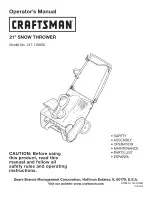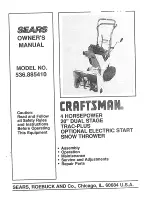
13
NOTE: Operate the snow thrower in open areas until you
are familiar with these controls.
To Engage Drive
1. With the engine running near top speed, move
shift lever to one of six FORWARD positions or two
REVERSE positions. Select a speed appropriate for
the snow conditions that exist. Do not shift speeds
while the drive is engaged.
2. Squeeze drive control against the right handle and
the snow thrower will move. Release it and the drive
motion will stop.
3. To turn the unit left or right, squeeze the respective
wheel steering control. See Figure 4-1.
To Engage Augers
1. To engage augers and start snow throwing, squeeze
the left hand auger control against the left handle.
Release to stop augers.
2. While the auger control is engaged, squeeze the drive
control to move, release to stop. Do not shift speeds
while the drive is engaged.
NOTE: This drive lever also locks auger control so you
can turn the chute control without interrupting the snow
throwing process.
3. Release the auger control; the interlock mechanism
should keep the auger control engaged until the drive
control is released.
4. Release the drive control to stop both the augers and
the wheel drive. To stop the auger, both levers must
be released.
Auger Control Test
Perform the following test before operating your snow
thrower for the first time and at the start of each winter.
Check the adjustment of the auger control as follows:
1. When the auger control is released and in the
disengaged “up” position, the cable should have very
little slack. It should NOT be tight.
2. In a well-ventilated area, start the snow thrower
engine as instructed on the previous page. Make sure
the throttle is set in the FAST position.
3. While standing in the operator’s position (behind the
snow thrower), engage the auger.
When selecting a
Drive Speed, use the
slower speeds until
you are comfortable
and familiar with the
operation of the snow
thrower.
NEVER reposition the
shift lever (change
speeds or direction
of travel) without first
releasing the drive
control and bringing
the snow thrower
to a complete stop.
Doing so will result in
premature wear to the
snow thrower’s drive
system.
WARNING
The muffler, engine
and surrounding
areas become hot
and can cause a burn
150°F (65°C). Do not
touch.
Figure 4-2
4. Allow the auger to remain engaged for approximately
ten (10) seconds before releasing the auger control.
Repeat this several times.
5. With the auger control in the disengaged “up” posi-
tion, walk to the front of the machine.
6. Confirm that the auger has completely stopped
rotating and shows NO signs of motion. If the auger
shows ANY signs of rotating, immediately return to
the operator’s position and shut off the engine. Wait
for ALL moving parts to stop before re-adjusting the
auger control.
7. To readjust the control cable, loosen the upper hex
nut on the auger cable bracket. See Figure 4-2.
8. Position the bracket upward to provide more slack (or
downward to increase cable tension).
9. Retighten the upper hex nut.
10. Repeat Auger Control Test to verify proper adjustment
has been achieved.
Tire Pressure
The tires are over-inflated for shipping purposes. Check
the tire pressure before operating the snow thrower.
Refer to the tire side wall for tire manufacturer’s recom-
mended psi and deflate (or inflate) the tires as necessary.
WARNING: Under any circumstance
do not exceed manufacturer’s recom-
mended psi. Equal tire pressure should
be maintained at all times. Excessive
pressure when seating beads may
cause tire/rim assembly to burst with
force sufficient to cause serious injury.
Refer to sidewall of tire for recom-
mended pressure.






































